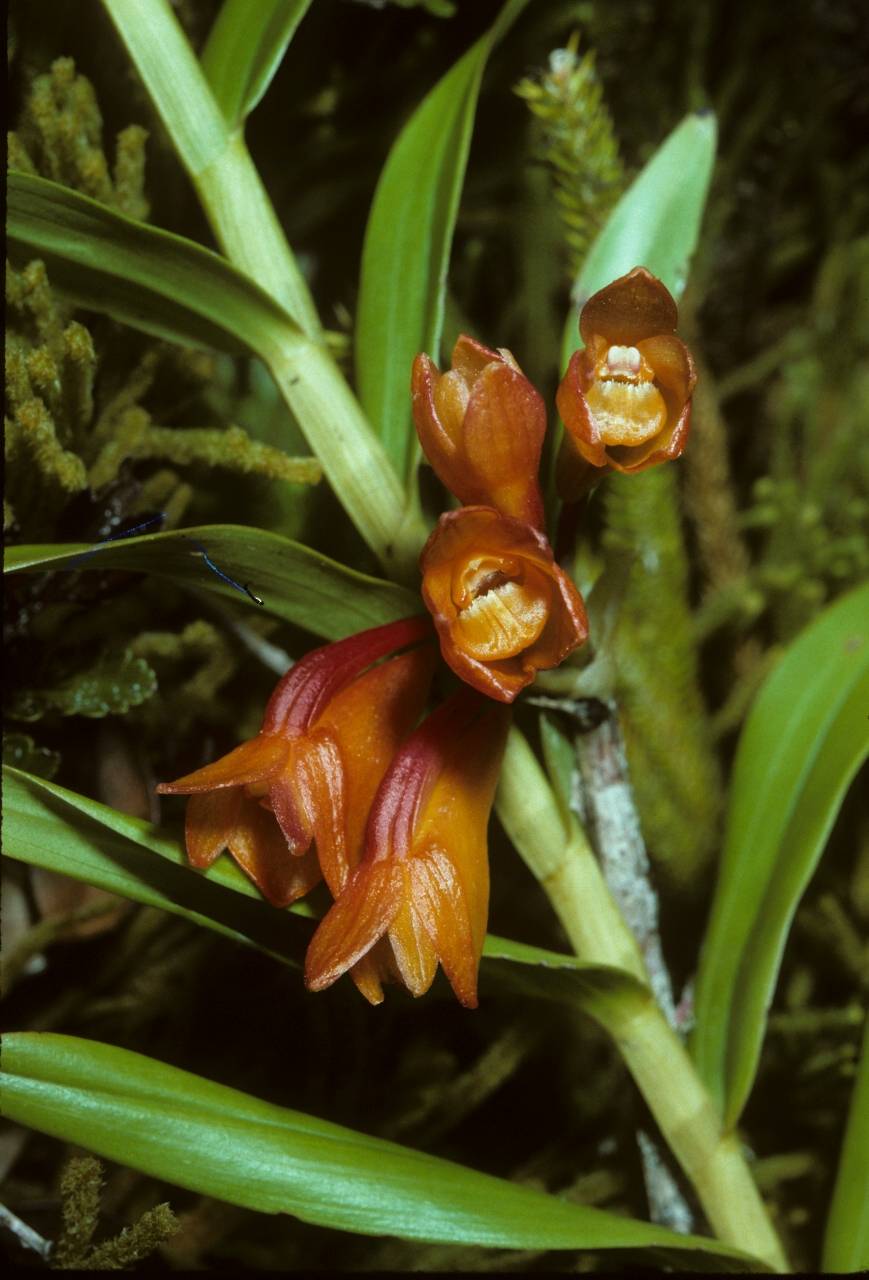
Holotype. Whistler 3957 (PTBG, isotype BISH) collected on Mt. Vaivai Crater, ‘Upolu, ca. 1060 m, 29 August 1978.
= Dendrobium mohlianum sensu Kraenzl., Bot. Jahrb. 25: 604 (1898). Schltr., Repert. Sp. Nov. 9: 102 (1911); Christoph., Bishop Mus. Bull. 128: 66 (1935); Cribb & Whistler, Orchids of Samoa 97 (1996); non Rchb. f. (1862)
Medium-sized epiphytic orchid with clustered, slender, many-noded stems up to 45 (–70) cm or more in length and 1.5–4 mm in diameter, yellow and ribbed with age. Leaves distichous, concentrated apically, sometimes imbricate on the stem; blade coriaceous, lanceolate to elliptic-lanceolate, 5–10 × 0.8–1.4 cm, broadly acute at the base, narrowly acute at the tip; sessile, with the sheath 1.5–3 cm long. Inflorescence a short, compact, 3–8-flowered raceme arising from the internode of a leafless stem, with a peduncle ca. 3 mm long; floral bracts ovate, chaffy, 5–9 mm long. Flowers with sepals orange or maroon on the outside, orange on the inside, petals orange, these all spreading little at anthesis; resupinate. Sepals similar, fleshy, ovate, 7–9 × ca. 5, subacute at the tip; mentum retrorse, narrowly conical, 1–1.6 cm long. Petals ovate, similar to and slightly smaller than the sepals. Lip clawed, entire obovate, upcurved and crimped at the broad apex, 3-lobed, 9–11 × 6–7 mm; side lobes erect, obscurely elliptic, acute at the tip; midlobe ovate, sparsely papillate, acute at the tip; callus a central longitudinal ridge; column 3–4 mm long; foot 1–1.6 cm long. Ovary inferior, maroon, 1-celled, with parietal placentation. Stamen comprising 2 pollinia. Fruit an oblanceoloid, ribbed capsule 2–3 cm long excluding the persistent perianth, on a pedicel about half as long. Flowering and fruiting probably occur throughout the year.
Distribution and Habitat. Endemic to Samoa, where it is occasional to locally common in montane to cloud forest on Savai‘i and ‘Upolu, reported from 1000 to 1780 m elevation. Only a single recent collection (the holotype) has been collected on the latter island. Despite its attractive appearance, no local names or uses have been recorded for this species, mostly because of its occurrence far from habitations.
Specimens Seen. SAVAII: Reinecke 437 (presumed lost); Vaupel 180 (K), 578 (K); Christophersen 829 (BISH, K); Whistler 2490 (BISH, PTBG, K), 2543 (PTBG), 2667 (PTBG), 8876 (PTBG), 10070 (PTBG), 10090 (PTBG), 12777 (PTBG). UPOLU: Whistler 3957 (BISH, PTBG).
Etymology. The epithet flammeus reflects the species flower color as being related to a flame or flaming.
Copyright ©2018 W.A Whistler. Data portal development has been supported through the cooperation of the Ministry of Natural Resources and Environment, The Government of Samoa.
We are currently actively uploading datasets for this project.
Powered by Symbiota software.Usage Policy.



